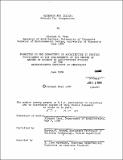| dc.contributor.advisor | Harvey J. Bryan. | en_US |
| dc.contributor.author | Ness, Richard E | en_US |
| dc.contributor.other | Massachusetts Institute of Technology. Dept. of Architecture. | en_US |
| dc.date.accessioned | 2013-01-23T20:20:10Z | |
| dc.date.available | 2013-01-23T20:20:10Z | |
| dc.date.copyright | 1984 | en_US |
| dc.date.issued | 1984 | en_US |
| dc.identifier.uri | http://hdl.handle.net/1721.1/76545 | |
| dc.description | Thesis (M.S.)--Massachusetts Institute of Technology, Dept. of Architecture, 1984. | en_US |
| dc.description | MICROFICHE COPY AVAILABLE IN ARCHIVES AND ROTCH | en_US |
| dc.description | Vita. | en_US |
| dc.description | Includes bibliographical references (p. 77-81). | en_US |
| dc.description.abstract | This study investigates the major factors which inhibit and foster the integration and application of research knowledge with design practice. The results are presented in two parts: Part I, a generic user handbook, and Part II, a series of case studies dealing with specific matters in research and design. Part 1: RESEARCH AND DESIGN, presents various relationships between scientific inquiry and intuitive design in as broad a context as is possible. Six chapters are arranged to illustrate definitions, major players, · incentives, barriers, solutions, and communications methods. Part II: METHODS FOR INTEGRATION, presents situations and tools which assist in the integration of research and design. Six case studies identify the following methods: design competitions, grantsmanship, financial tools, research methods, and business development strategies. Together, Part I and Part II are intended to serve as a useful tool for researchers and designers to aid in understanding and executing an integration of architectural research and architectural design. This book can be used as a teaching and learning aid in architectural schools, conferences or symposia, as a useful method for transferring technology from other disciplines, or as a design practitioner's tool in determining economic feasibility for applications of building technology to the built environment. A conclusion drawn from this investigation is that sufficient demand must be created before optimum communication is reached between the research and design communities. This research addresses this fundamental requirement by seeking to motivate researchers and designers with moral, legal, and economic incentives, and cost-effective methods. | en_US |
| dc.description.statementofresponsibility | by Richard E. Ness. | en_US |
| dc.format.extent | [181] p. in various pagings | en_US |
| dc.language.iso | eng | en_US |
| dc.publisher | Massachusetts Institute of Technology | en_US |
| dc.rights | M.I.T. theses are protected by
copyright. They may be viewed from this source for any purpose, but
reproduction or distribution in any format is prohibited without written
permission. See provided URL for inquiries about permission. | en_US |
| dc.rights.uri | http://dspace.mit.edu/handle/1721.1/7582 | en_US |
| dc.subject | Architecture. | en_US |
| dc.title | Research and design : methods for integration | en_US |
| dc.title.alternative | Research and practice design in architecture : incentives for a synthesis | en_US |
| dc.type | Thesis | en_US |
| dc.description.degree | M.S. | en_US |
| dc.contributor.department | Massachusetts Institute of Technology. Department of Architecture | |
| dc.identifier.oclc | 11709750 | en_US |
